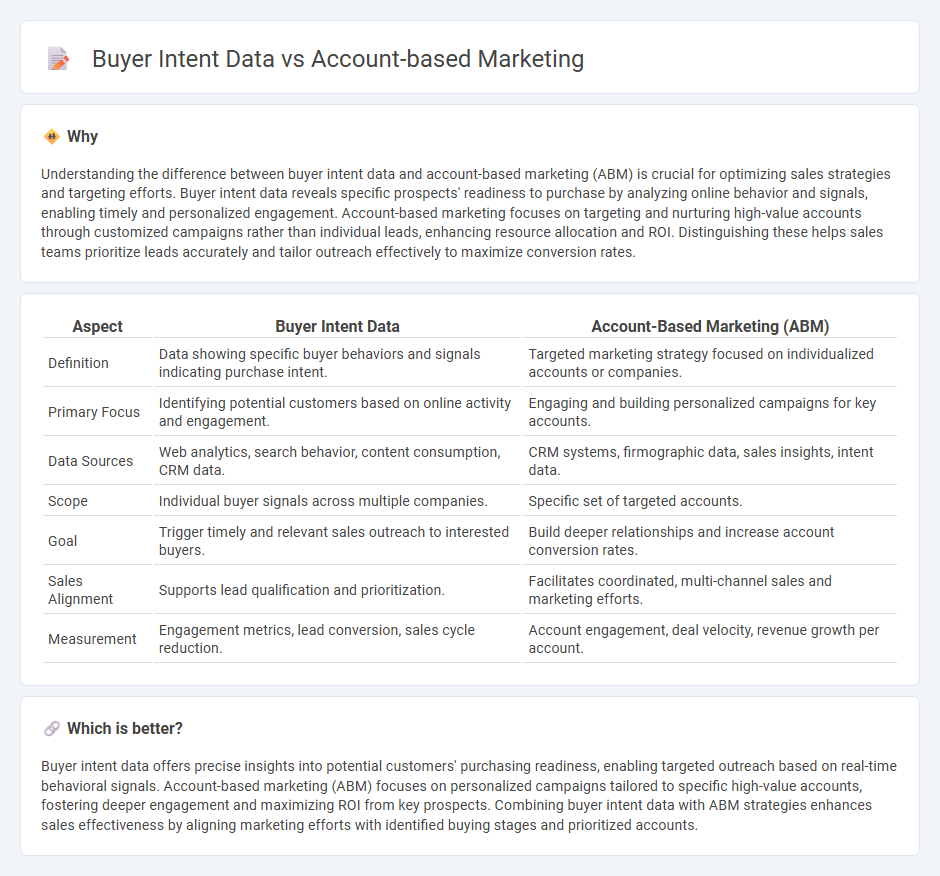
Buyer intent data provides actionable insights by tracking real-time behaviors and signals indicating a prospect's readiness to purchase, enhancing precision targeting within sales strategies. Account-based marketing (ABM) focuses on personalized campaigns tailored to high-value accounts, aligning marketing and sales efforts to maximize engagement and conversion rates. Explore how integrating buyer intent data with ABM can accelerate pipeline growth and improve ROI.
Why it is important
Understanding the difference between buyer intent data and account-based marketing (ABM) is crucial for optimizing sales strategies and targeting efforts. Buyer intent data reveals specific prospects' readiness to purchase by analyzing online behavior and signals, enabling timely and personalized engagement. Account-based marketing focuses on targeting and nurturing high-value accounts through customized campaigns rather than individual leads, enhancing resource allocation and ROI. Distinguishing these helps sales teams prioritize leads accurately and tailor outreach effectively to maximize conversion rates.
Comparison Table
| Aspect | Buyer Intent Data | Account-Based Marketing (ABM) |
|---|---|---|
| Definition | Data showing specific buyer behaviors and signals indicating purchase intent. | Targeted marketing strategy focused on individualized accounts or companies. |
| Primary Focus | Identifying potential customers based on online activity and engagement. | Engaging and building personalized campaigns for key accounts. |
| Data Sources | Web analytics, search behavior, content consumption, CRM data. | CRM systems, firmographic data, sales insights, intent data. |
| Scope | Individual buyer signals across multiple companies. | Specific set of targeted accounts. |
| Goal | Trigger timely and relevant sales outreach to interested buyers. | Build deeper relationships and increase account conversion rates. |
| Sales Alignment | Supports lead qualification and prioritization. | Facilitates coordinated, multi-channel sales and marketing efforts. |
| Measurement | Engagement metrics, lead conversion, sales cycle reduction. | Account engagement, deal velocity, revenue growth per account. |
Which is better?
Buyer intent data offers precise insights into potential customers' purchasing readiness, enabling targeted outreach based on real-time behavioral signals. Account-based marketing (ABM) focuses on personalized campaigns tailored to specific high-value accounts, fostering deeper engagement and maximizing ROI from key prospects. Combining buyer intent data with ABM strategies enhances sales effectiveness by aligning marketing efforts with identified buying stages and prioritized accounts.
Connection
Buyer intent data enhances account-based marketing (ABM) by identifying high-value accounts actively researching products or services, enabling targeted campaigns that increase conversion rates. Integrating real-time intent signals allows sales and marketing teams to prioritize efforts on accounts showing strong purchase signals, optimizing resource allocation and boosting ROI. This data-driven approach refines personalization strategies, resulting in higher engagement and accelerated sales cycles within key accounts.
Key Terms
**Account-Based Marketing:**
Account-Based Marketing (ABM) targets specific high-value accounts with personalized campaigns, leveraging detailed firmographic and technographic data to increase engagement and ROI. Unlike Buyer Intent Data that analyzes real-time signals indicating purchase readiness, ABM emphasizes nurturing long-term relationships within strategically chosen organizations. Discover how ABM can transform your B2B strategy by driving focused, measurable growth.
Target Accounts
Account-based marketing (ABM) targets specific high-value accounts with personalized campaigns to maximize engagement and conversion rates. Buyer intent data identifies signals from target accounts indicating readiness to purchase, enabling more precise timing and messaging for outreach. Explore how integrating ABM with intent data sharpens focus on target accounts for improved sales outcomes.
Personalization
Account-based marketing (ABM) targets highly specific accounts with personalized campaigns, leveraging detailed firmographic and behavioral insights to tailor messaging for key decision-makers. Buyer intent data enhances personalization by analyzing real-time signals of potential customers' online behavior, indicating their readiness to purchase, which refines ABM strategies for precise engagement. Discover how integrating ABM with buyer intent data can elevate your personalization efforts and drive higher conversion rates.
Source and External Links
What is account based marketing? - Account-based marketing (ABM) is a B2B marketing strategy focusing resources on a specific set of target accounts, providing personalized marketing and strong alignment between sales and marketing teams to improve customer experience and sales outcomes.
Your guide to account-based marketing (ABM) - ABM requires collaboration between sales and marketing to map customer journeys, qualify leads, and use specialized ABM platforms for tailored engagement with target accounts.
Account-Based Marketing (ABM) - ABM treats each account as a "market of one," delivering highly personalized experiences to build stronger relationships that increase pipeline quality, deal sizes, and revenue growth.
 dowidth.com
dowidth.com